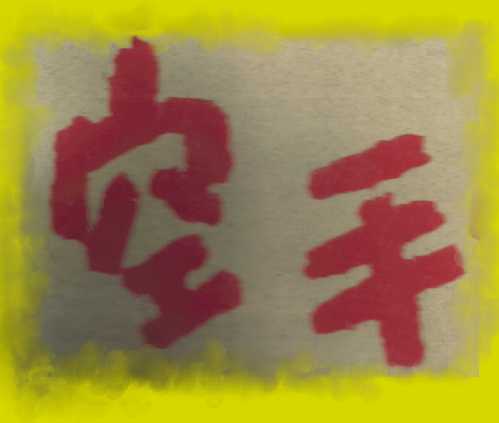Rejection of Chinese Influence
 As we can see from the Chinese connection between China and Okinawa, no one can deny the fact that Gung Fu shaped the formation of karate. In fact, before the '20s karate was translated as Chinese Hand, not the Empty Hand today.
As we can see from the Chinese connection between China and Okinawa, no one can deny the fact that Gung Fu shaped the formation of karate. In fact, before the '20s karate was translated as Chinese Hand, not the Empty Hand today.
The reasons given by Mr Funakoshi (Shotokan founder) in his article of why he changed the "kara" (China) to "kara" (Empty) were pretty convincing. He construed that the karate practised in Japan was so unique and developed that there was already no Chinese relations in it; the reason was simply due to xenocentrism. Then he gave his reason why it should be changed to empty(kara) hand by bringing up Buddhism tenets. Also later he changed the name of kata and wholly rejected the Chinese relation. This can be seen in his book "Karate: Master text".
However, if we understand a little bit of the history between China and Japan, the downturn of Ching government of China during the late 19th century invited the evasion of foreigners which also included the Japanese who conquered three provinces in Northeastern China. The respect given by Japan to the once strong and big China deteriorated and eventually deviated to disgust. They started referring to Chinese as Tzina (a degradation of similar stature as the African-American 'nigger') which is unfortunately still being used by extremists in Japan today.
As a result, the military-ruled Japanese certainly could not accept the fact that their bare-fisted fighting method was really taught by the inferior Chinese to the old Okinawan masters. Thence came the rejection of Chinese values in karate.
Post War
After the World War II, karate morphed into a more popular form of practise suitable for children and women. Training was still tough but the effectiveness of karate was reserved. Difficult techniques by older masters like Mr Funakoshi lapsed and were forgotten.
Example
Where has this brought us? Today a 5th Dan karateka might think that a low X-block in kata Heian Yondan or Pinan Yondan is just an X-block to an oncoming kick (The Sunday Star 25th July 1999 carries a demonstration by a karate master, a perfect example).
But do you really need a low stance and both hands to block a low kick? What happens to the head?
 Waiting to be punched? Have you seen this sort of blocking in tournaments, rings or street fights? You think the old masters who designed this kata decades ago were idiots? Why can't it be a strangling technique from a opponent's back using your front knee to push his spine, with the X-block actually operating as a strangling pull and squeeze that could apply in Judo. How about an X-punch to the connection between the back of the head and neck: Gall Bladder 20 (see picture)? Who says karate needs only kick and block and punch?
Waiting to be punched? Have you seen this sort of blocking in tournaments, rings or street fights? You think the old masters who designed this kata decades ago were idiots? Why can't it be a strangling technique from a opponent's back using your front knee to push his spine, with the X-block actually operating as a strangling pull and squeeze that could apply in Judo. How about an X-punch to the connection between the back of the head and neck: Gall Bladder 20 (see picture)? Who says karate needs only kick and block and punch?
The Worldwide Dilemma ...
After WWII and especially in the 60's, karate and judo spread around the world thanks to American marines based in Japan and globe-trotting instructors from JKA (Japan Karate Association) and Kodokan. This could be the reason why hidden techniques in karate were not known after WWII. Personally I wouldn't teach any gaijin (foreigner) who defeated my country in the war. Why then bother spreading the art at all, you may ask.
In my opinion there are three important reasons. Firstly, karate today is a sport with little ability of self-defence against an untrained person. Sending a latter-day exponent of Shotokan, Shitoryu, Wadoryu or a Judoka to fight Muay Thai world champions or well-known individuals like Rickson Gracie is merely an act of kamikaze (suicidal act).
 Secondly, by spreading karate to the world a country's image is promoted; Karate=Japan, Judo=Japan. Thirdly, karate and judo are sports and when they are well-known enough in the world, they would be accepted into the Olympic Games. Judo is now recognised as an Olympic event. Doesn't that help Japan to obtain more gold medals? Like karate, judo no longer serves as an art of self-defence, its just the size matters.
Secondly, by spreading karate to the world a country's image is promoted; Karate=Japan, Judo=Japan. Thirdly, karate and judo are sports and when they are well-known enough in the world, they would be accepted into the Olympic Games. Judo is now recognised as an Olympic event. Doesn't that help Japan to obtain more gold medals? Like karate, judo no longer serves as an art of self-defence, its just the size matters.
Author's Words
Bubishi I is just a very brief introductory history of karate, whereas Bubishi II raises some hot points that are not mentioned or written due to political reasons. The author hopes that karate enthusiasts would be able to realise and understand the gist of the article. The idea is not to have one's eyes forever shut, or worship that which has been passed down duplicitously.